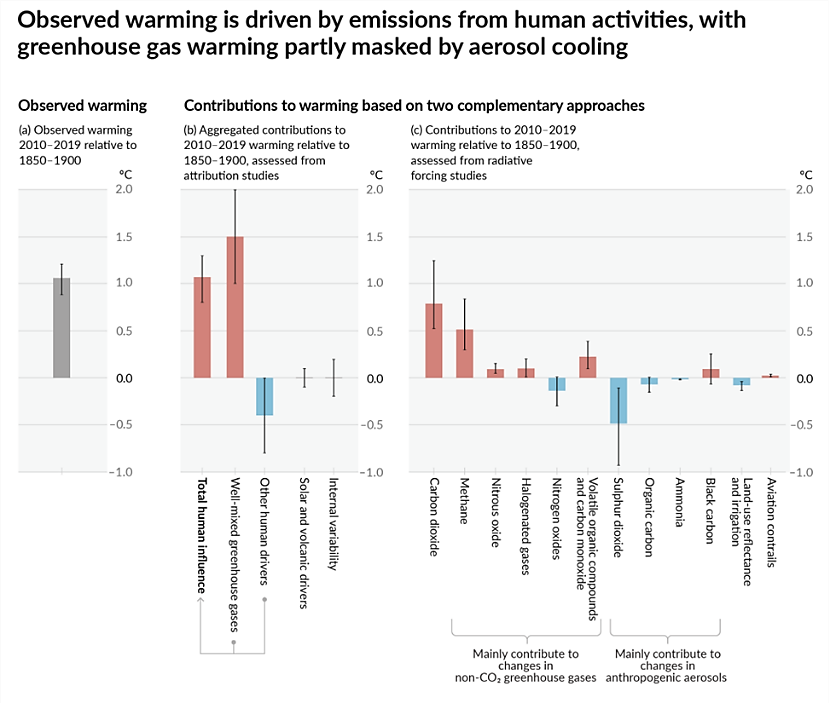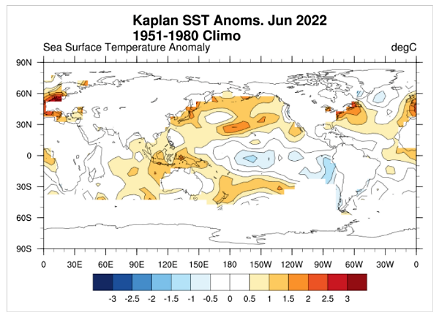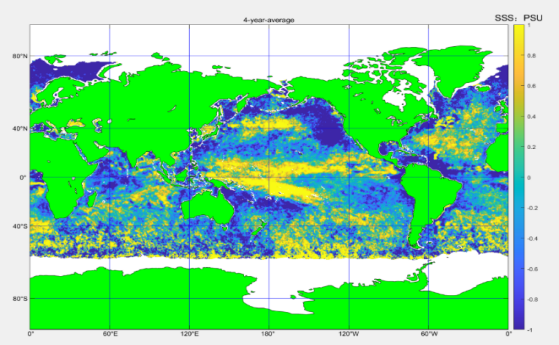1. Introduction
The Atlantic Meridional Overturning Circulation (AMOC) is one of the most significant oceanic systems in the world, playing a crucial role in global heat and salinity distribution [1]. The AMOC has a substantial impact not only on the climate of Europe [2], but also on the sea temperature and salinity in the Atlantic. Figure 1 illustrates gridded global SST anomalies from 1856 to the present, derived from UK Met Office SST data, with the Pacific and Atlantic Oceans at 60N highlighted. It is evident that the SST in the North Atlantic is substantially higher than that in the Pacific [3]. Numerous studies have demonstrated that the weakening of AMOC [4], a crucial component of the global climate, is responsible for this phenomenon, which enables Europe to remain sufficiently warm to support a large population and agricultural industry [5]. As shown in Figure 1, the weakening of AMOC is predominantly the result of human-caused global warming due to greenhouse gas and aerosol emissions since the Industrial Revolution [6-8]. Long-term observations and models have provided abundant evidence of AMOC deceleration. As depicted in Figure 2, the SST in the North Atlantic, particularly in the sub-polar region, is decreasing despite a global warming trend. Figure 3 depicts long-term observations of salinity accumulation in the Atlantic, which have been observed to be more extensive and significant than in other oceans. Both Figures 2 and 3 provide compelling long-term observational evidence of the effects of a slowed AMOC. Nonetheless, short-term salinity variability is still mainly unexplored [9].

Figure 1. Warming distribution showing humans are responsible [6].

Figure 2. Map of the linear trends 1900–2019 of observed sea surface temperature (SST, °C/120 years) [10].

Figure 3. Linear trends in SSS (psu century−1) for 1950–2017 (EN4) SST (K century−1) [11].
This study analyzes a decade's worth of satellite remote sensing data of sea surface salinity and investigates the 4-year-scale variations to investigate short-term variability and its connection to the weakening AMOC. Using observational data, our analysis verifies a short-term increase in Atlantic salinity and provides evidence of an AMOC slowdown under anthropogenic warming. Nonetheless, many concerns remain. For instance, insufficient continuous observational remote sensing data makes it challenging to discern the trend of short-term variation. In addition, a global salinity variability has been identified, which differs significantly from decadal or centennial SSS anomalies, indicating that a second factor, other than the AMOC's intensity, is redistributing salinity globally over a relatively brief period of time.
2. Methodology
Downloadable from SMAP sea surface salinity (SSS) V5.0 are monthly SSS data for the Atlantic and Pacific encompassing 70-km fields from 2015 to 2022 [12]. Using a Backus-Gilbert type optimum interpolation (OI), we were able to resample the 70-km product onto a 0.25° fixed Earth grid, thereby making the 70-km product smoother and reducing random noise relative to other SMAP products. By selecting data from the same month each year, we can ensure the data's consistency and avoid the effects of seasonal variations. With SSS data of the same month, which is every June, from 2015 to 2022, a smoothed and averaged 4-year variation data can be drawn using the equation,
sss \( =-\sum _{2015}^{2018}{sss_{i}}+\sum _{2019}^{2022}{sss_{i}} \) .
where \( sss \) represents the variation of the 4 years and \( ss{s_{i}} \) represents the sea surface salinity of the year i, which varies from 2015 to 2022. The increase or decrease of \( sss \) can be more evidently presented by limiting the range of the color bar between -1 to 1.
3. Results
After analyzing the available data on short-term Atlantic salinity accumulation, it is evident that this phenomenon is a consequence of the AMOC slowing due to human-caused warming. As shown in Figure 4, both the centennial and 4-year-scale trends in sea surface salinity (SSS) exhibit a similar pattern of salinity accumulation in the North Atlantic region, indicating that this phenomenon can be detected not only through long-term observations, but also through short-term observations. Salinity anomalies were also detected in the Pacific region during both the 1950-2017 and 2015-2022 observation periods, lending further credence to short-term observations.
Notably, the 4-year-scale salinity accumulation observed between 2015 and 2022 was found to be comparable in amplitude to the century-long variation observed between 1950 and 2017. This indicates that the salinity accumulation mechanism may have an impact that grows over time. To better comprehend the causes and effects of this phenomenon and to assess its potential effects on global climate and ocean circulation, additional research is required.
| |
(a) | (b) |
Figure 4. Linear trends in SSS. (a) Observational linear trends in SSS (psu century−1) for 1950–2017. (b)Observational 4-year-averaged linear trends in SSS (psu 4-year−1) for 2015-2022 [12]. | |
4. Discussion
The Atlantic Meridional Overturning Circulation (AMOC) performs an important role in the global oceanic system by transporting warm, upper waters northward and cooler, deeper, and saltier waters southward. In addition to being a significant source of heat transport to the north, the AMOC also functions as a conveyor belt for salt. A weakening of the AMOC would result in a buildup of salt in the subpolar regions because the AMOC would be less effective at transporting saline water southward. In contrast, there would be a cooling effect close to the equator.
In this study, we present evidence of a salinity increase in the sub-polar south and north Atlantic, and a salinity decrease near the equator. Our findings support the conclusion that subpolar North Atlantic surface waters are becoming fresher and colder, while subtropical North Atlantic surface waters are becoming warmer and saltier. This result is consistent with long-term observations and is likely attributable to the same underlying cause.
A 2020 study used the Atlantic's alinity pile-up' as a salinity indicator to illustrate the remote response of the AMOC decline [11]. The Atlantic salinity pile-up refers to a greater trend in basin-mean salinity, which eliminates the effect of surface evaporation minus precipitation (E-P), indicating a salinity increase from the surface to the thermocline in the subtropical Atlantic region compared to the Indo-Pacific region. This confirms that the Atlantic salinity anomaly is indeed caused by the AMOC decline.
In addition, it is essential to note that the meridional overturning circulation of the ocean is governed by density, which is determined by both temperature and salinity. Saltier water is denser while warmer water is lighter. Consequently, the freshening and warming of the North Atlantic can impede the AMOC's flow.
However, a global redistribution of salinity is also observed, indicating that there is a salinity accumulation in the Pacific that cannot be attributed to a weakening AMOC. However, the driving force behind the global redistribution of salinity will undoubtedly have an effect on the Atlantic and may even exacerbate the salinity accumulation.
Although the function of AMOC deterioration in Atlantic salinity accumulation has been acknowledged, additional research is required to determine its relative contribution. In addition, the traditional pattern of salinity accumulation may not be solely attributable to AMOC response, but may also be the result of intensified atmospheric hydrological cycles. Short-term observations imply a global redistribution of salinity that is likely driven by factors other than the variability of the AMOC.
Freshwater flux, which is affected by the intensification of the global hydrological cycle due to global warming, is one of the primary factors influencing SSS. Due to the "rich-getting-richer" precipitation response triggered by surface evaporation minus precipitation, this has resulted in decreasing SSS trends at low and high latitudes and increasing SSS trends in subtropical Pacific regions.
Given the limitations of the observational period, future research should employ climate models to supplement observations and obtain additional understanding of the relationship between salinity anomalies and AMOC weakening.
5. Conclusion
After analyzing the available data on short-term Atlantic salinity accumulation, it is evident that this phenomenon is a consequence of the AMOC slowing due to human-caused warming. However, additional research is required to comprehend the relative contributions of AMOC and other factors that influence salinity accumulation, particularly longer-term observations.
The accumulation of complementary salinity in the Pacific region suggests that the global redistribution of salinity may also contribute to the observed alterations in the Atlantic region. When analyzing the Atlantic salinity accumulation, it is therefore necessary to consider the broader context of climate change.
Future satellite observations of SSS data with a higher resolution over an extended time period, as well as modeling, will be essential for understanding the mechanisms underlying the observed changes. These tools can shed light on the relationship between the anomalies and a weakening AMOC, as well as enhance our understanding of the roles of other factors, such as the freshwater flux and the intensification of the global hydrological cycle.
The findings of this study underscore the need for continued monitoring and research on Atlantic salinity accumulation in order to gain a deeper understanding of the effects of climate change on oceanic systems.
References
[1]. Kostov, Y., Armour, K. C., and Marshall, J., Impact of the Atlantic meridional overturning circulation on ocean heat storage and transient climate change, Geophys. Res. Lett., 41, 2108– 2116, (2014)
[2]. Sévellec, F., Fedorov, A. & Liu, W. Arctic sea-ice decline weakens the Atlantic Meridional Overturning Circulation. Nature Clim Change 7, 604–610 (2017).
[3]. Polyakov, I.V., Alexeev, V.A., Bhatt, U.S. et al. North Atlantic warming: patterns of long-term trend and multidecadal variability. Clim Dyn 34, 439–457 (2010).
[4]. Caesar, L., McCarthy, G.D., Thornalley, D.J.R. et al. Current Atlantic Meridional Overturning Circulation weakest in last millennium. Nat. Geosci. 14, 118–120 (2021).
[5]. Chen, X., Tung, KK. Global surface warming enhanced by weak Atlantic overturning circulation. Nature 559, 387–391 (2018).
[6]. IPCC: Summary for Policymakers. In Climate Change 2021: Te Physical Science Basis (eds Masson-Delmotte, V. et al.) (Cambridge Univ. Press, in the press).(2021)
[7]. Booth, B. B. B., Dunstone, N. J., Halloran, P. R., Andrews, T. & Bellouin, N. Aerosols implicated as a prime driver of twentieth-century North Atlantic climate variability. Nature 484, 228–232 (2012).
[8]. Menary, M. B. et al. Aerosol‐forced AMOC changes in CMIP6 historical simulations. Geophys. Res. Lett, (2020).
[9]. Jackson, L.C., Biastoch, A., Buckley, M.W. et al. The evolution of the North Atlantic Meridional Overturning Circulation since 1980. Nat Rev Earth Environ 3, 241–254 (2022). https://doi.org/10.1038/s43017-022-00263-2
[10]. Latif M, Sun J, Visbeck M, et al. Natural variability has dominated Atlantic Meridional Overturning Circulation since 1900[J]. Nature Climate Change, 2022, 12(5): 455-460.
[11]. Zhu, C., Liu, Z. Weakening Atlantic overturning circulation causes South Atlantic salinity accumulation. Nat. Clim. Chang. 10, 998–1003 (2020). https://doi.org/10.1038/s41558-020-0897-7
[12]. T. Meissner, F. J. Wentz, A. Manaster, R. Lindsley, M. Brewer, M. Densberger, 2022: Remote Sensing Systems SMAP Ocean Surface Salinities [Level 2C, Level 3 Running 8- day, Level 3 Monthly], Version 5.0 validated release. Remote Sensing Systems, Santa Rosa, CA, USA. Available online at www.remss.com/missions/smap, doi: 10.5067/SMP50- 3SMCS.
Cite this article
Qiu,J. (2023). Analysis on the relationship between short-term variability and the weakening AMOC. Theoretical and Natural Science,7,1-6.
Data availability
The datasets used and/or analyzed during the current study will be available from the authors upon reasonable request.
Disclaimer/Publisher's Note
The statements, opinions and data contained in all publications are solely those of the individual author(s) and contributor(s) and not of EWA Publishing and/or the editor(s). EWA Publishing and/or the editor(s) disclaim responsibility for any injury to people or property resulting from any ideas, methods, instructions or products referred to in the content.
About volume
Volume title: Proceedings of the 2023 International Conference on Environmental Geoscience and Earth Ecology
© 2024 by the author(s). Licensee EWA Publishing, Oxford, UK. This article is an open access article distributed under the terms and
conditions of the Creative Commons Attribution (CC BY) license. Authors who
publish this series agree to the following terms:
1. Authors retain copyright and grant the series right of first publication with the work simultaneously licensed under a Creative Commons
Attribution License that allows others to share the work with an acknowledgment of the work's authorship and initial publication in this
series.
2. Authors are able to enter into separate, additional contractual arrangements for the non-exclusive distribution of the series's published
version of the work (e.g., post it to an institutional repository or publish it in a book), with an acknowledgment of its initial
publication in this series.
3. Authors are permitted and encouraged to post their work online (e.g., in institutional repositories or on their website) prior to and
during the submission process, as it can lead to productive exchanges, as well as earlier and greater citation of published work (See
Open access policy for details).
References
[1]. Kostov, Y., Armour, K. C., and Marshall, J., Impact of the Atlantic meridional overturning circulation on ocean heat storage and transient climate change, Geophys. Res. Lett., 41, 2108– 2116, (2014)
[2]. Sévellec, F., Fedorov, A. & Liu, W. Arctic sea-ice decline weakens the Atlantic Meridional Overturning Circulation. Nature Clim Change 7, 604–610 (2017).
[3]. Polyakov, I.V., Alexeev, V.A., Bhatt, U.S. et al. North Atlantic warming: patterns of long-term trend and multidecadal variability. Clim Dyn 34, 439–457 (2010).
[4]. Caesar, L., McCarthy, G.D., Thornalley, D.J.R. et al. Current Atlantic Meridional Overturning Circulation weakest in last millennium. Nat. Geosci. 14, 118–120 (2021).
[5]. Chen, X., Tung, KK. Global surface warming enhanced by weak Atlantic overturning circulation. Nature 559, 387–391 (2018).
[6]. IPCC: Summary for Policymakers. In Climate Change 2021: Te Physical Science Basis (eds Masson-Delmotte, V. et al.) (Cambridge Univ. Press, in the press).(2021)
[7]. Booth, B. B. B., Dunstone, N. J., Halloran, P. R., Andrews, T. & Bellouin, N. Aerosols implicated as a prime driver of twentieth-century North Atlantic climate variability. Nature 484, 228–232 (2012).
[8]. Menary, M. B. et al. Aerosol‐forced AMOC changes in CMIP6 historical simulations. Geophys. Res. Lett, (2020).
[9]. Jackson, L.C., Biastoch, A., Buckley, M.W. et al. The evolution of the North Atlantic Meridional Overturning Circulation since 1980. Nat Rev Earth Environ 3, 241–254 (2022). https://doi.org/10.1038/s43017-022-00263-2
[10]. Latif M, Sun J, Visbeck M, et al. Natural variability has dominated Atlantic Meridional Overturning Circulation since 1900[J]. Nature Climate Change, 2022, 12(5): 455-460.
[11]. Zhu, C., Liu, Z. Weakening Atlantic overturning circulation causes South Atlantic salinity accumulation. Nat. Clim. Chang. 10, 998–1003 (2020). https://doi.org/10.1038/s41558-020-0897-7
[12]. T. Meissner, F. J. Wentz, A. Manaster, R. Lindsley, M. Brewer, M. Densberger, 2022: Remote Sensing Systems SMAP Ocean Surface Salinities [Level 2C, Level 3 Running 8- day, Level 3 Monthly], Version 5.0 validated release. Remote Sensing Systems, Santa Rosa, CA, USA. Available online at www.remss.com/missions/smap, doi: 10.5067/SMP50- 3SMCS.











